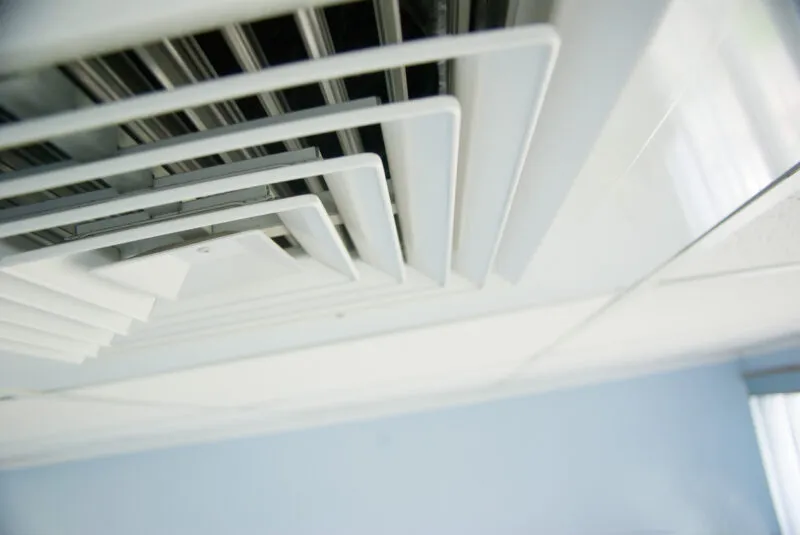Ceiling Vents vs. Floor Vents: Creating the Best Energy-Efficient for Your Space

One of the greatest mysteries in home ventilation design is the difference between ceiling and floor vents. Those who move to a new climate are the most likely to experience this strange phenomenon. You might either grow up with one or the other. So what is the difference between ceiling vents and floor vents? Which is better when installing new ventilation or ductwork in your home? Which is more energy-efficient?
The answer lies in the climate, the design of your home, and whether you’ll be doing more heating or cooling throughout the year.
Ceiling Vents: Ideal for Cooling in Warm Climates
Ceiling vents are most often seen in warmer climates. “Central cooling” systems have ducts hidden behind walls and ceilings with vents in the ceiling or the wall close to the ceiling. This is the most efficient cooling design because cold air sinks.
1. Better Airflow for Cooling
Cold air falls and warm air rises. Therefore, ceiling vents help to cool an entire room because cold air starts at the top and drifts down to fill the space. Ceiling vents provide the best airflow for even cooling because that fall induces a cycle as warm air is pushed out of the way.
2. Improved Aesthetic Flexibility
Ceiling vents are easier to work with than floor vents. They are difficult to block (only the tallest shelves are a risk). They also provide a cleaner look because they are typically out of sight above your eyeline.
3. Works Well With High Ceilings
Ceiling vents are excellent for homes and rooms with high ceilings. They can help cool the entire space and promote comfortable airflow in spaces where air might otherwise become stuffy in the vaulted reaches.
Energy Efficiency Factors
Ceiling vents are the most energy-efficient choice for warm climates when homes cool most of the year. The air movement from top to bottom reduces the fan pressure required to maintain a consistent temperature throughout the house.
Floor Vents: Perfect for Heating in Cooler Climates
Floor vents are ideal in regions with a colder climate where homes heat most of the year. Warm air rises, meaning rooms become warm from bottom to top. Just as cold air causes airflow by dropping, warm air provides airflow by rising. Floor vents allow heat to rise and fill each room.
1. Efficient Heating
When your primary concern is heating the house, floor vents are more efficient. Warm air fills the room as it rises, ensuring the area near the floor remains warm and more elevated spaces become warm over time. This allows warm feet, pets, children, and couch snuggling even in the coldest months.
2. Ideal for Single-Story Homes
Floor vents work best in single-story homes. They allow heat to spread evenly without pushing warm air from the ceiling to the floor.
3. Easier Maintenance
Floor vents don’t require ladders or reaching to clean or maintain. However, furniture often obstructs them. Either they restrict your floor plan design or furniture might restrict the airflow.
Energy Efficiency Factors
Floor vents are the most energy-efficient option for homes in colder climates because warm air rises. This provides efficient heating if your home is set to ‘heat’ for most of the year.
Which Option Is More Energy-Efficient for Your Space?
If you are debating your home’s ceiling vs. floor vent installation, consider the climate and your home’s layout.
Ceiling Vents for Warm Weather
If your region has hot summers and tends to be warm in the spring and fall, ceiling vents are the ideal choice. They provide energy-efficient cooling if your HVAC will be switched to ‘cool’ for most of the year.
Floor Vents for Cold Weather
If your region has deep freeze winters and is cold in the spring and autumn, floor vents are your best option. They provide efficient heating if your system is switched to ‘heat’ for most of the year.
Other Factors to Consider
- Multiple Stories: Ceiling vents work better for upper stories, while floor vents are most efficient on the first floor or basement. Consider a combination system if you have a home with two or more levels.
- HVAC System Type: Different types of HVAC are attuned to floor or ceiling vents for efficiency. Check with your HVAC installer.
- Insulation: Better insulation can make either vent placement more efficient.
Ceiling or Floor Vents?
When your goal is energy efficiency, the climate and floors of your home will help you decide which type of vent to install. Ceiling vents are almost always the right answer due to Florida’s warm climate and many single-story homes. To design the most energy-efficient HVAC and ventilation system for your home, contact Aztil to consult with a professional team and plan your installation.












